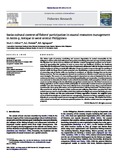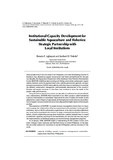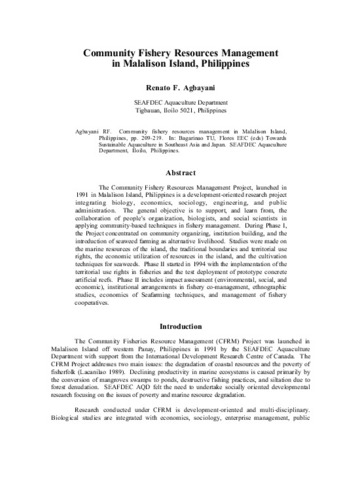Community fishery resources management on Malalison Island, Philippines: R & D framework, interventions, and policy implications

View/
Request this document
Date
2000Page views
251Metadata
Show full item recordCited times in Scopus
Share
Abstract
In 1991, the Aquaculture Department of the Southeast Asian Fisheries Development Center launched a community-based fishery resources management project on Malalison Island, in central Philippines, to help conserve the country's marine resources and to help the fisherfolk rise above their poverty. The eight-year project integrated various disciplines in biology, economics, sociology, public administration, and engineering in its study of fishery resources and fishing communities and in evolving intervention strategies for resource conservation and management, and for community development. The project's most important accomplishment was the inculcation among the fisherfolk of the importance of resource conservation and management. The most important lesson learned was that an enlightened and empowered fisherfolk could be effective managers and responsible users of fishery resources.
Suggested Citation
Agbayani, R. F., Baticados, D. B., & Siar, S. V. (2000). Community fishery resources management on Malalison Island, Philippines: R & D framework, interventions, and policy implications. Coastal Management , 28(1), 19-27. https://doi.org/10.1080/089207500263611
Subject
aquaculture  ; aquaculture development
; aquaculture development  ; aquaculture enterprises
; aquaculture enterprises  ; artisanal fishing
; artisanal fishing  ; coastal zone management
; coastal zone management  ; policies
; policies  ; developing countries
; developing countries  ; economics
; economics  ; fishery management
; fishery management  ; fishery resources
; fishery resources  ; institutional resources; living resources; marine fisheries
; institutional resources; living resources; marine fisheries  ; political aspects; sociology
; political aspects; sociology  ; tropical climate
; tropical climate  ; Philippines
; Philippines  ; Philippines, Panay I., Antique, Culasi, Malalison I.; Community-based fishery resources management; interdisciplinary research
; Philippines, Panay I., Antique, Culasi, Malalison I.; Community-based fishery resources management; interdisciplinary research 
 ; aquaculture development
; aquaculture development  ; aquaculture enterprises
; aquaculture enterprises  ; artisanal fishing
; artisanal fishing  ; coastal zone management
; coastal zone management  ; policies
; policies  ; developing countries
; developing countries  ; economics
; economics  ; fishery management
; fishery management  ; fishery resources
; fishery resources  ; institutional resources; living resources; marine fisheries
; institutional resources; living resources; marine fisheries  ; political aspects; sociology
; political aspects; sociology  ; tropical climate
; tropical climate  ; Philippines
; Philippines  ; Philippines, Panay I., Antique, Culasi, Malalison I.; Community-based fishery resources management; interdisciplinary research
; Philippines, Panay I., Antique, Culasi, Malalison I.; Community-based fishery resources management; interdisciplinary research 
Collections
- AQD Journal Articles [1215]
Related items
Showing items related by title, author, creator and subject.
-
Socio-cultural context of fishers’ participation in coastal resources management in Anini-y, Antique in west central Philippines
Aldon, Ma. Eva T.; Fermin, Armando C.; Agbayani, Renato F. (Elsevier, 2011)The vicious cycle of poverty, overfishing and resource degradation in coastal communities in the Philippines calls for action that will address the problem of declining fish catch and degraded fish habitats. The literature ... -
Institutional capacity development for sustainable aquaculture and fisheries: Strategic partnership with local institutions
Agbayani, Renato F.; Toledo, Joebert D. (Terrapub, 2008)Many people living in the rural areas in the Philippines, as in other developing countries in Southeast Asia, depend on aquatic resources for their food and livelihood. For the past two decades, the Aquaculture Department ... -
Community fishery resources management in Malalison Island, Philippines
Agbayani, Renato F. (Aquaculture Department, Southeast Asian Fisheries Development Center, 1995)The Community Fishery Resources Management Project, launched in 1991 in Malalison Island, Philippines is a development-oriented research project integrating biology, economics, sociology, engineering, and public administration. ...



